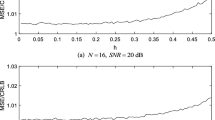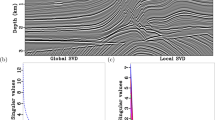Abstract
Sparse component analysis (SCA) has been extensively studied to solve undetermined blind source separation problem in various fields over the last decades. This paper proposes a SCA algorithm based on hierarchical Hough transform. The hyperplanes clustering within the mixture space are revealed as local maxima in the parameter space after Hough transform is performed. Then, the local maxima are picked up, and the mixing matrix is calculated. The grid resolution in which the parameter space is divided plays an important role on the estimation error and the computational load. Therefore, the parameter space is divided into hypercubes recursively from low to high resolution, and Hough transform is performed only on the hypercubes with votes exceeding a selected threshold. The grid resolution selection problem is solved, and the computational load is reduced a lot in the meantime. After the mixing matrix is obtained, the sources are recovered with \(\ell _1\)-norm optimization. Numerical simulation and a speech separation application illustrate the superior performance of the proposed algorithm.









Similar content being viewed by others
References
S. Barbarossa, Analysis of multicomponent lfm signals by a combined Wigner–Hough transform. IEEE Trans. Signal Process. 43(6), 1511–1515 (1995)
A. Belouchrani, K. AbedMeraim, J.F. Cardoso, E. Moulines, A blind source separation technique using second-order statistics. IEEE Trans. Signal Process. 45(2), 434–444 (1997)
P. Bofill, M. Zibulevsky, Underdetermined blind source separation using sparse representations. Signal Process. 81(11), 2353–2362 (2001)
P.S. Bradley, O.L. Mangasarian, k-plane clustering. J. Glob. Optim. 16(1), 23–32 (2000)
X.R. Cao, R.W. Liu, General approach to blind source separation. IEEE Trans. Signal Process. 44(3), 562–571 (1996)
S.S.B. Chen, D.L. Donoho, M.A. Saunders, Atomic decomposition by basis pursuit. SIAM J. Sci. Comput. 20(1), 33–61 (1998)
S.S.B. Chen, D.L. Donoho, M.A. Saunders, Atomic decomposition by basis pursuit. SIAM Rev. 43(1), 129–159 (2001)
S.J. Choi, A. Cichocki, A. Belouchrani, Second order nonstationary source separation. J. Vlsi Signal Process. Syst. Signal Image Video Technol. 32(1–2), 93–104 (2002)
A. Cichocki, S. Amari, Adaptive Blind Signal and Image Processing (Wiley, Chichester, 2002)
L.A. Cirillo, A.M. Zoubir, M.G. Amin, Direction finding of nonstationary signals using a time-frequency Hough transform, in 2005 IEEE International Conference on Acoustics, Speech, and Signal Processing, vol. 1–5 (2005), pp. 501–504
P. Comon, Independent component analysis, a new concept. Signal Process. 36(3), 287–314 (1994)
D.L. Donoho, Compressed sensing. IEEE Trans. Inf. Theory 52(4), 1289–1306 (2006)
P. Georgiev, F. Theis, A. Cichocki, Sparse component analysis and blind source separation of underdetermined mixtures. IEEE Trans. Neural Netw. 16(4), 992–996 (2005)
P.G. Georgiev, F. Theis, A. Cichocki, Optimization algorithms for sparse representations and applications. Multisc. Optim. Methods Appl. 82, 85–99 (2006)
I.F. Gorodnitsky, B.D. Rao, Sparse signal reconstruction from limited data using focuss: a re-weighted minimum norm algorithm. IEEE Trans. Signal Process. 45(3), 600–616 (1997)
Z.S. He, A. Cichocki, Y.Q. Li, S.L. Me, S. Sanei, K-hyperline clustering learning for sparse component analysis. Signal Process. 89(6), 1011–1022 (2009)
P.V.C. Hough, Method and means for recognizing complex patterns: U.S. Patent 3,069,654[P]. 1962-12-18
H.W. Li, M.A. Lavin, R.J. Lemaster, Fast Hough transform—a hierarchical approach. Comput. Vis. Graph. Image Process. 36(2–3), 139–161 (1986)
J. Lin, D. Grier, J. Cowan, Feature extraction approach to blind source separation, in Proceedings of the 1997 IEEE Workshop (1997), pp. 398–405
B.A. Olshausen, D.J. Field, Emergence of simple-cell receptive field properties by learning a sparse code for natural images. Nature 381(6583), 607–609 (1996)
J. Princen, J. Illingworth, J. Kittler, A hierarchical approach to line extraction based on the Hough transform. Comput. Vis. Graph. Image Process. 52(1), 57–77 (1990)
V.G. Reju, S.N. Koh, I.Y. Soon, An algorithm for mixing matrix estimation in instantaneous blind source separation. Signal Process. 89(9), 1762–1773 (2009)
I. Takigawa, M. Kudo, J. Toyama, Performance analysis of minimum l(1)-norm solutions for underdetermined source separation. IEEE Trans. Signal Process. 52(3), 582–591 (2004)
F.J. Theis, P. Georgiev, A. Cichocki, Robust sparse component analysis based on a generalized Hough transform. EURASIP J. Adv. Signal Process. 2007(1), 86–86 (2007)
Y. Tsaig, D.L. Donoho, Extensions of compressed sensing. Signal Process. 86(3), 549–571 (2006)
E. van den Berg, M.P. Friedlander, SPGL1: a solver for large-scale sparse reconstruction (2007)
E. van den Berg, M.P. Friedlander, Probing the Pareto frontier for basis pursuit solutions. SIAM J. Sci. Comput. 31(2), 890–912 (2008)
Y.C. Yang, S. Nagarajaiah, Output-only modal identification with limited sensors using sparse component analysis. J. Sound Vib. 332(19), 4741–4765 (2013)
M. Zibulevsky, B.A. Pearlmutter, Blind source separation by sparse decomposition in a signal dictionary. Neural Comput. 13(4), 863–882 (2001)
Acknowledgments
This work was supported by the National Key Basic Research Program of China (973 Program) under Grant No. 2014CB049500 and the Key Science and Technologies Program of Anhui Province under Grant No. 1301021005.
Author information
Authors and Affiliations
Corresponding author
Rights and permissions
About this article
Cite this article
Jin, Y., Qin, S. & Zhu, C. Sparse Component Analysis Based on Hierarchical Hough Transform. Circuits Syst Signal Process 36, 1569–1585 (2017). https://doi.org/10.1007/s00034-016-0374-8
Received:
Revised:
Accepted:
Published:
Issue Date:
DOI: https://doi.org/10.1007/s00034-016-0374-8




